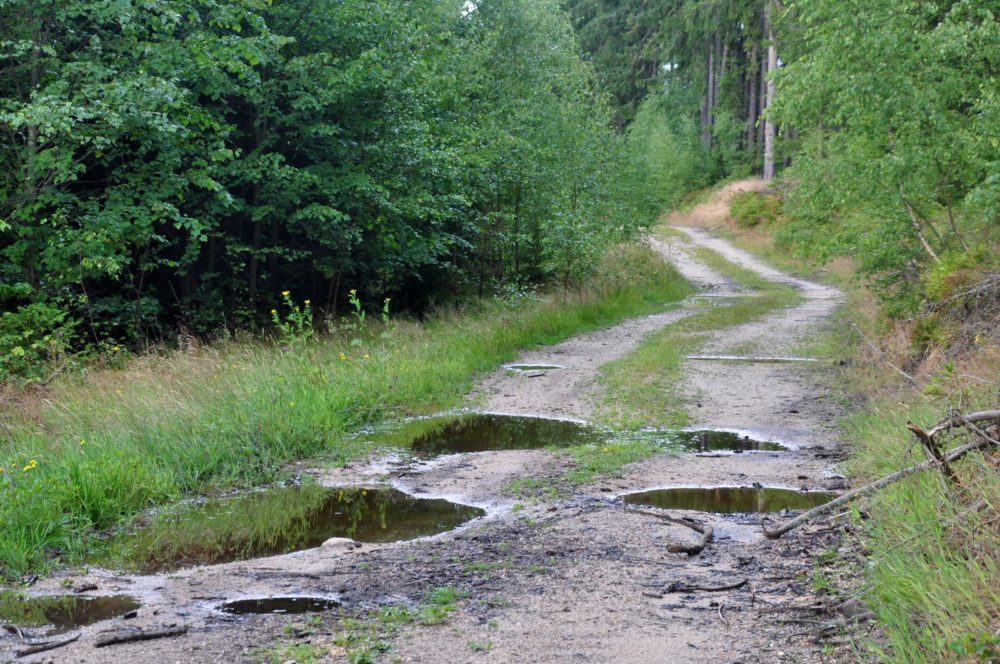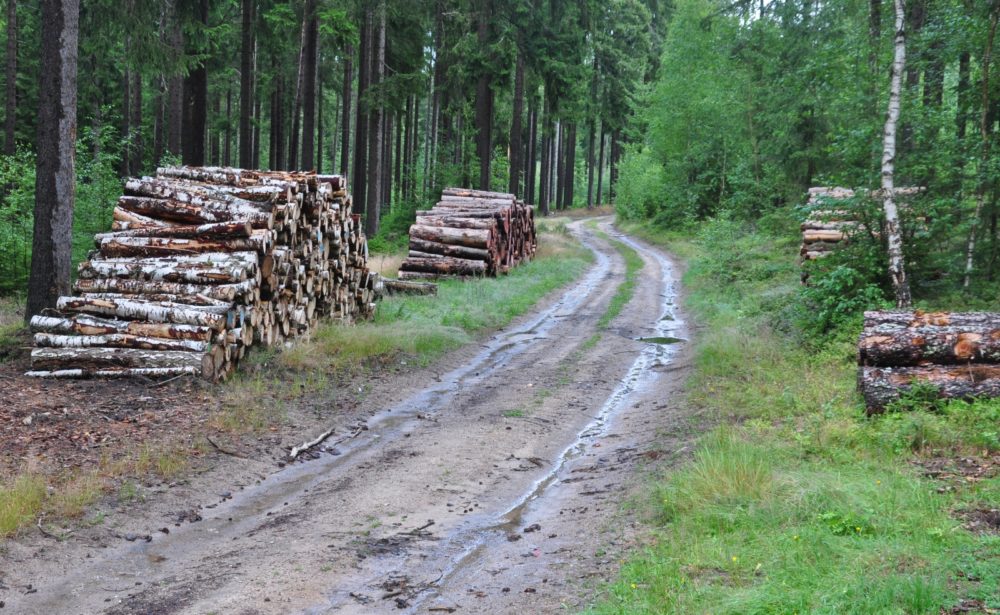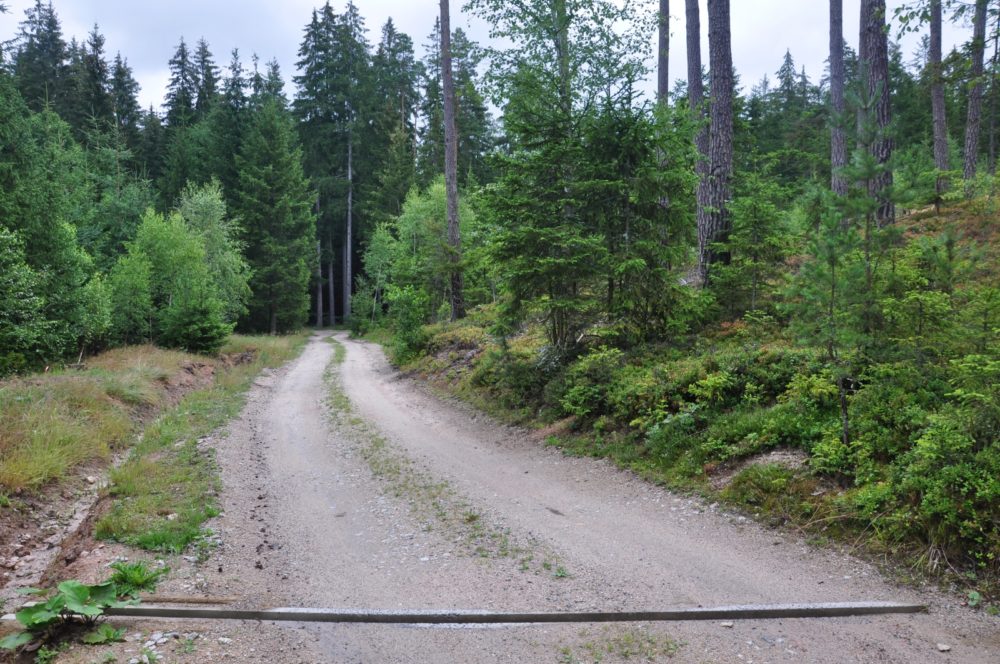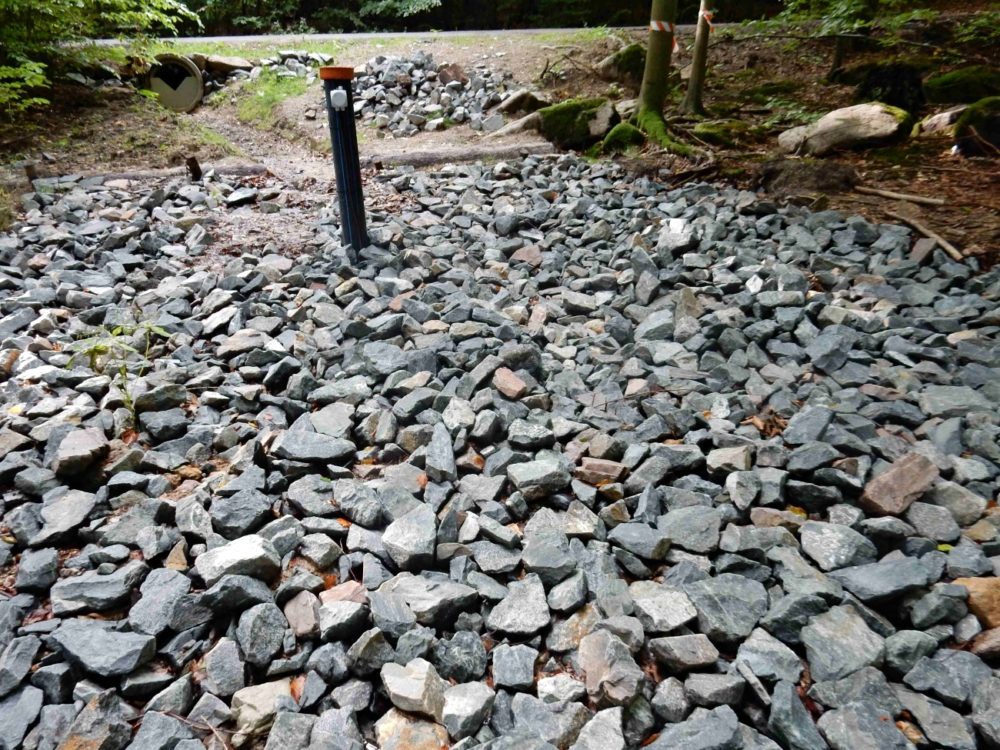How to reduce surface water runoff on forest roads
 Water management in the landscape represents one of the cornerstones of sustainable agriculture and forestry, today. It is aimed to retaining water and slowing its outflow. In the forest environment, the main source of surface runoff is forest roads, otherwise, it occurs only occasionally. Infiltration devices built on forest road structures, especially pipe culverts, are intended to slow down or limit the rapid outflow of water from the forest.
Water management in the landscape represents one of the cornerstones of sustainable agriculture and forestry, today. It is aimed to retaining water and slowing its outflow. In the forest environment, the main source of surface runoff is forest roads, otherwise, it occurs only occasionally. Infiltration devices built on forest road structures, especially pipe culverts, are intended to slow down or limit the rapid outflow of water from the forest.
Photo: Forest road after rain, author Jan Řezáč
Scientists from the Mendel University in Brno and the Czech University of Life Sciences in Prague are dealing with this issue when solving the research project Technical recommendations for water management within the forest transport network /Technická doporučení pro hospodaření s vodou v rámci lesní dopravní sítě/ (project No. QK2020146). They published their first preliminary results in the paper Functionality of infiltration pits on forest transportation network (Vsakovací zařízení na lesní dopravní síti a jejich funkčnost), which was published in the journal Reports of Forestry Research 2/2023.
The construction of infiltration facilities is intended to solve the reduction of surface runoff concentrated in the ditches of forest roads and to ensure water infiltration into the soil and rock environment. At present, however, it is not known what the effectiveness of the soaking equipment is and whether it is expedient and cost-effective to design them across the entire territory of the Czech Republic.
 Photo: Forest road after rain, with roadside banding, author Jan Řezáč
Photo: Forest road after rain, with roadside banding, author Jan Řezáč
The construction of forest roads can play a significant role in changing the hydrological response of the catchment and accelerating erosion processes. Despite their small area, forest roads have a considerable influence on runoff conditions.
The high degree of forest roads’ compaction roads results in their low capacity to keep water and low absorption capacity. Therefore, during intense rainfall, surface runoff occurs that exceeds the infiltration rate.
Infiltration facilities are designed to capture and infiltrate precipitation surface runoff into the nearby soil environment and groundwater. They can also have an anti-flood function – they reduce the maximum instantaneous volumes of flood waves. Most often, these are shallow holdings filled with filter medium (stones, gravel), usually covered with geotextiles to prevent the penetration of fine soil particles and clogging of the filter medium.
Today, infiltration devices are commonly used to capture precipitation in the urban environment, they can include infiltration systems, retention tanks, vegetation overhangs with bio filtration, sand filters, ponds, vegetation belts, or rainwater tanks. The use of infiltration devices presents an imaginary approach in water management to the restoration of the natural water cycle.
Regarding drought problems in various parts of the world, infiltration, and other rainwater management devices are experiencing a great wave of interest. Since the beginning of the 21st century, water retention devices have come to the forefront of interest even outside the urban environment.
 Photo: Forest road with transverse and longitudinal drainage, author Jan Řezáč
Photo: Forest road with transverse and longitudinal drainage, author Jan Řezáč
Infiltration devices, similar to those being used in the urban environment, are just occasionally used in world forestry practice. Respectively, there are no scientific findings about their implementation, function, and effectiveness.
In the Czech Republic, similarly to the world, there are infiltration devices on forest roads implemented individually and spontaneously, without any knowledge of their long-term effects and functionality.
The ČSN 73 6108 standard considers the design of infiltration devices on forest roads. Practically, these are infiltration devices such as weirs, reservoirs, furrows, ditches, shafts, under pipe culverts outside permanent watercourses. However, there are no published results or experiences about their implementation, operation, efficiency, or maintenance.
Infiltration devices in the forest environment have the potential to mitigate the main negative effects of forest roads on the landscape water regime. In particular, this involves limiting surface runoff (its transformation into subsurface), limiting accelerated runoff from forests (by increasing retention and holding water in the soil), and reducing the risk of erosion (by capturing runoff in the retention space of infiltration devices).
Experimental verification of infiltration pits was carried out by scientists on selected sections of purpose-built forest roads on the localities of two school forestry districts at ČZU and MENDELU.
Two infiltration pits with a uniform retention volume were built at each locality. One of the pits is always located below the mouth of the pipe culvert, which flow is directed into the pit. The second control pit, is located about 30 m away from the first one, in the same pedological and vegetation conditions, at a place without connection to a culvert and without a concentrated inflow.
There are two spring areas in the locality of ŠLP Kostelec territory. Corresponding significant soil saturation with water also means a given range of soil moisture values beyond the retention water capacity. It is necessary to mention also the presence of gravitationally moving, but non-draining water, which results in prevailing or periodically occurring anoxic conditions. In the project, this is called as “wet variant“.
 Photo: The situation before filling the inlet with quarry stone at the Kostelec location; the plugging of the outlet of the culvert by the Thomson spillway can be seen here, as well as the inflow from the culvert into the seepage pit and the seepage pit itself (filled with quarry stone and fitted with a plugged borehole). Author J. Deutscher
Photo: The situation before filling the inlet with quarry stone at the Kostelec location; the plugging of the outlet of the culvert by the Thomson spillway can be seen here, as well as the inflow from the culvert into the seepage pit and the seepage pit itself (filled with quarry stone and fitted with a plugged borehole). Author J. Deutscher
The second locality is located on the ŠLP Křtiny territory. This place is characterized by low values of soil moisture during the whole season and especially during the growing season. This is a “dry” variant.
The data obtained so far demonstrate a very low surface runoff, or a very low (only isolated) flow in pipe culverts during the measured period. However, low surface runoff from the forest can be considered to be expected.
At the end of the paper, scientists present preliminary results (Autumn 2022). As these results indicate, the seepage pits under the culverts on the LDS (forest transportation net /lesní dopravní síť/) had an unexpectedly low efficiency in retaining and infiltrating surface runoff.
The surface runoff was at a minimal level in the analyzed period (the flow of the culvert was not registered), and water reached the pits only to a limited extent.
In the „dry variant“of the forest stand in ŠLP Křtiny, there was no infiltration (and probably no formation) of surface runoff inside the infiltration pit at all.
In case of the „wet variant“ at the ŠLP Kostelec territory, the results indicate that the impoundment objects were not filled by surface runoff, but by subsurface runoff in the saturated soil layer.
Thus, it seems that the infiltration pits under the LDS culverts did not reach the expected potential to reduce the negative effects of the road network on the hydric regime of the landscape in the analyzed period.
The article was created during the NAZV project No. QK2020146 “Technical recommendations for water management within the forest transport network” (Technická doporučení pro hospodaření s vodou v rámci lesní dopravní sítě) and preliminary results are presented here.
The paper Functionality of infiltration pits on forest transportation network (Vsakovací zařízení na lesní dopravní síti a jejich funkčnost), can be downloaded here.
Authors of the paper: Petr Kupec, Jan Deutscher, Ondřej Hemr, Petr Čech, MENDELU Brno; Karel Zlatuška, CZU in Prague; e-mail: petr.kupec@mendelu.cz
Prepared by: Ing. Jan Řezáč, VÚLHM, v. v. i., e-mail: rezac@vulhm.cz
